LAWS20060: Taxation Law of Australia Individual Assignment - Term 1
VerifiedAdded on 2023/01/18
|19
|4400
|95
Homework Assignment
AI Summary
This document presents a comprehensive solution to a Taxation Law assignment, addressing various aspects of Australian taxation. It covers topics such as the effective life of depreciating assets, tax offsets, tax rates, capital gains tax (CGT) events, and the calculation of income tax. The assignment delves into specific sections of the Income Tax Assessment Act 1997 (ITAA 1997) and relevant tax rulings, including TR 2018/4. The solution analyzes several scenarios, including deductions for interest on loans, apportionment of expenses, and the application of CGT to different situations like lease agreements and share sales. Key legal cases, such as Ure v FCT (1981), Ronpibon Tin NL v FCT (1949), and Charles Moore & Co (WA) Pty Ltd v FC of T (1956), are referenced to support arguments. The document also explores the differences between average and marginal tax rates and provides detailed calculations for capital gains tax, offering a thorough understanding of taxation principles and their practical application.
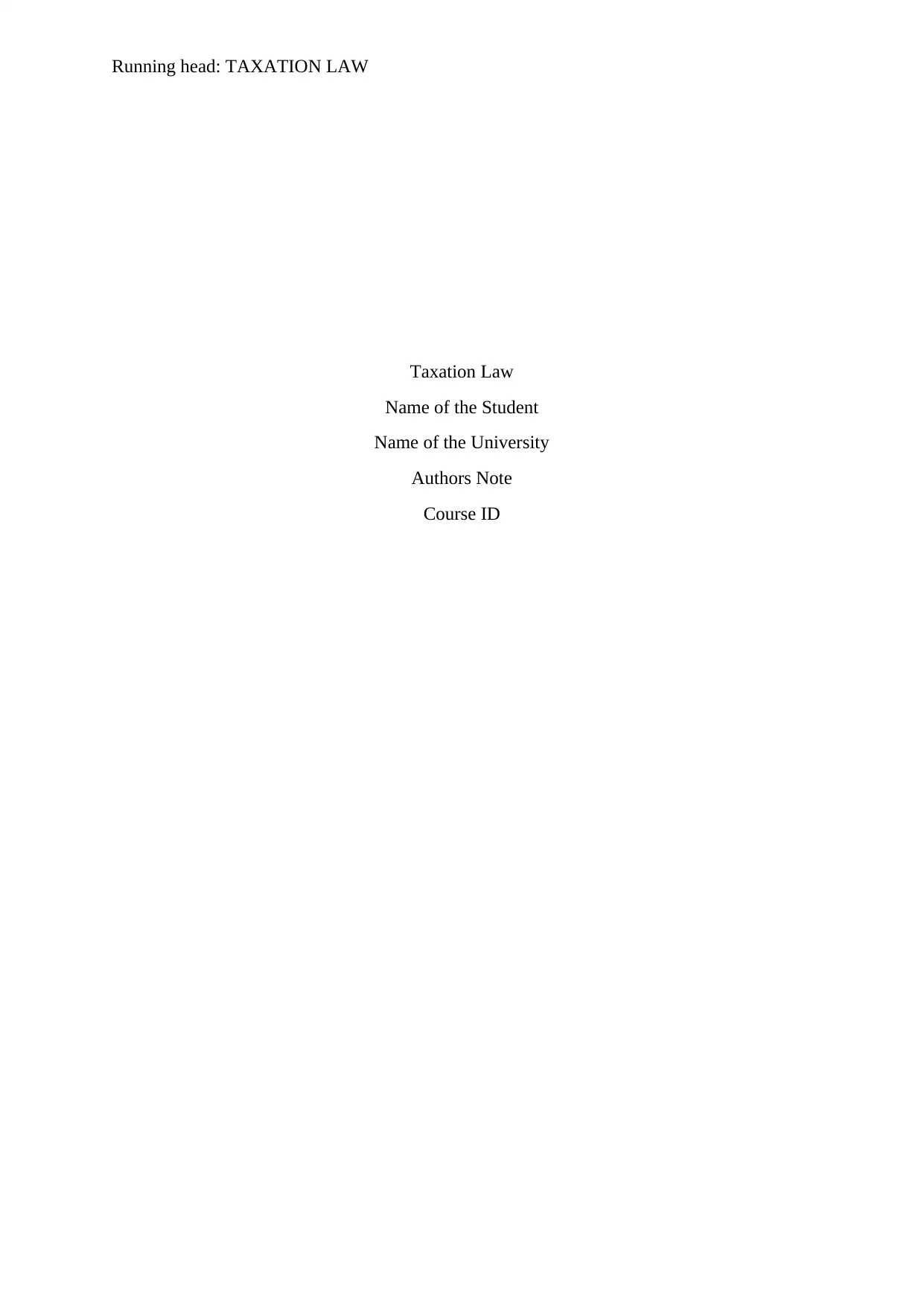
Running head: TAXATION LAW
Taxation Law
Name of the Student
Name of the University
Authors Note
Course ID
Taxation Law
Name of the Student
Name of the University
Authors Note
Course ID
Paraphrase This Document
Need a fresh take? Get an instant paraphrase of this document with our AI Paraphraser
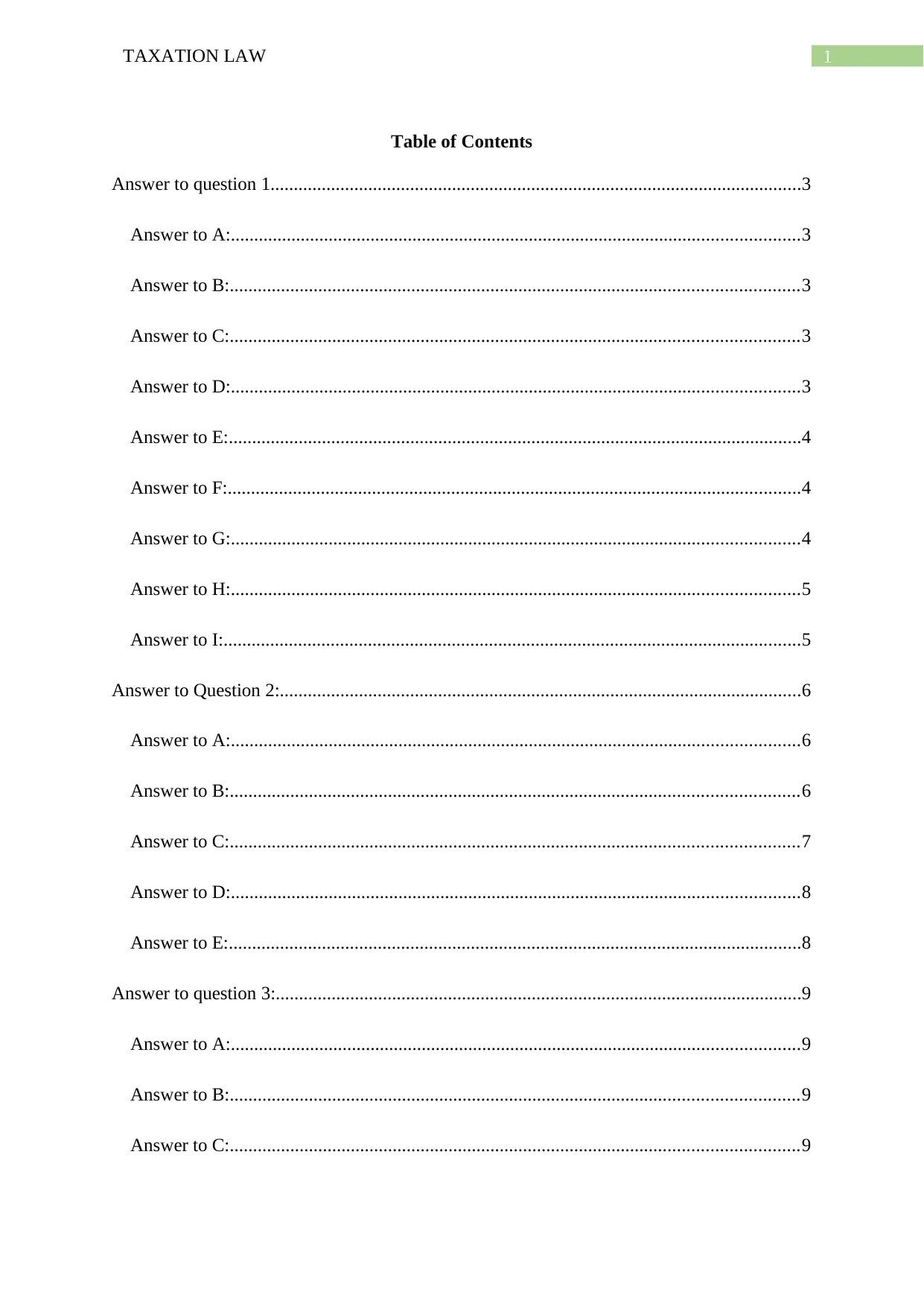
1TAXATION LAW
Table of Contents
Answer to question 1..................................................................................................................3
Answer to A:..........................................................................................................................3
Answer to B:..........................................................................................................................3
Answer to C:..........................................................................................................................3
Answer to D:..........................................................................................................................3
Answer to E:...........................................................................................................................4
Answer to F:...........................................................................................................................4
Answer to G:..........................................................................................................................4
Answer to H:..........................................................................................................................5
Answer to I:............................................................................................................................5
Answer to Question 2:................................................................................................................6
Answer to A:..........................................................................................................................6
Answer to B:..........................................................................................................................6
Answer to C:..........................................................................................................................7
Answer to D:..........................................................................................................................8
Answer to E:...........................................................................................................................8
Answer to question 3:.................................................................................................................9
Answer to A:..........................................................................................................................9
Answer to B:..........................................................................................................................9
Answer to C:..........................................................................................................................9
Table of Contents
Answer to question 1..................................................................................................................3
Answer to A:..........................................................................................................................3
Answer to B:..........................................................................................................................3
Answer to C:..........................................................................................................................3
Answer to D:..........................................................................................................................3
Answer to E:...........................................................................................................................4
Answer to F:...........................................................................................................................4
Answer to G:..........................................................................................................................4
Answer to H:..........................................................................................................................5
Answer to I:............................................................................................................................5
Answer to Question 2:................................................................................................................6
Answer to A:..........................................................................................................................6
Answer to B:..........................................................................................................................6
Answer to C:..........................................................................................................................7
Answer to D:..........................................................................................................................8
Answer to E:...........................................................................................................................8
Answer to question 3:.................................................................................................................9
Answer to A:..........................................................................................................................9
Answer to B:..........................................................................................................................9
Answer to C:..........................................................................................................................9
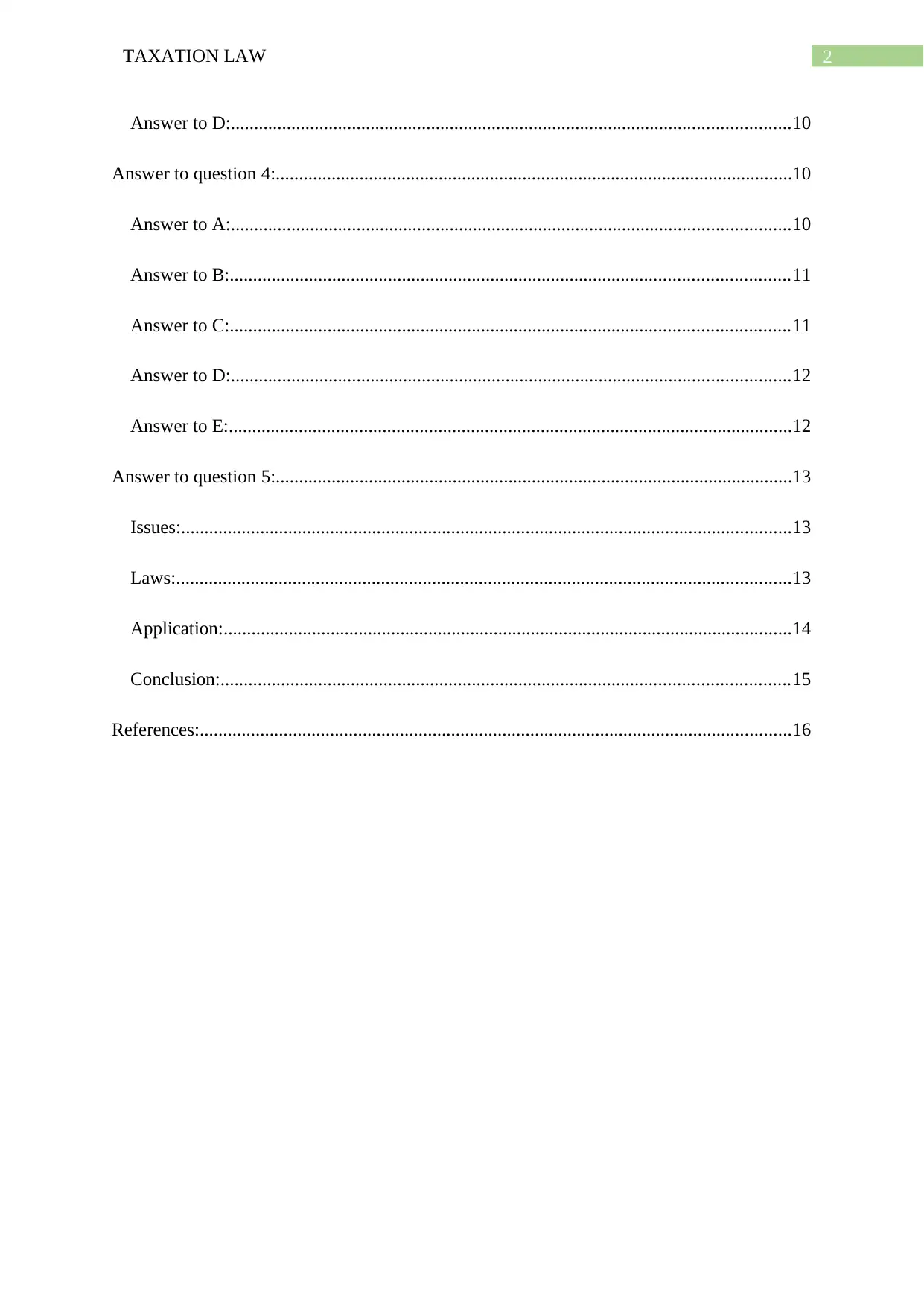
2TAXATION LAW
Answer to D:........................................................................................................................10
Answer to question 4:...............................................................................................................10
Answer to A:........................................................................................................................10
Answer to B:........................................................................................................................11
Answer to C:........................................................................................................................11
Answer to D:........................................................................................................................12
Answer to E:.........................................................................................................................12
Answer to question 5:...............................................................................................................13
Issues:...................................................................................................................................13
Laws:....................................................................................................................................13
Application:..........................................................................................................................14
Conclusion:..........................................................................................................................15
References:...............................................................................................................................16
Answer to D:........................................................................................................................10
Answer to question 4:...............................................................................................................10
Answer to A:........................................................................................................................10
Answer to B:........................................................................................................................11
Answer to C:........................................................................................................................11
Answer to D:........................................................................................................................12
Answer to E:.........................................................................................................................12
Answer to question 5:...............................................................................................................13
Issues:...................................................................................................................................13
Laws:....................................................................................................................................13
Application:..........................................................................................................................14
Conclusion:..........................................................................................................................15
References:...............................................................................................................................16
⊘ This is a preview!⊘
Do you want full access?
Subscribe today to unlock all pages.

Trusted by 1+ million students worldwide
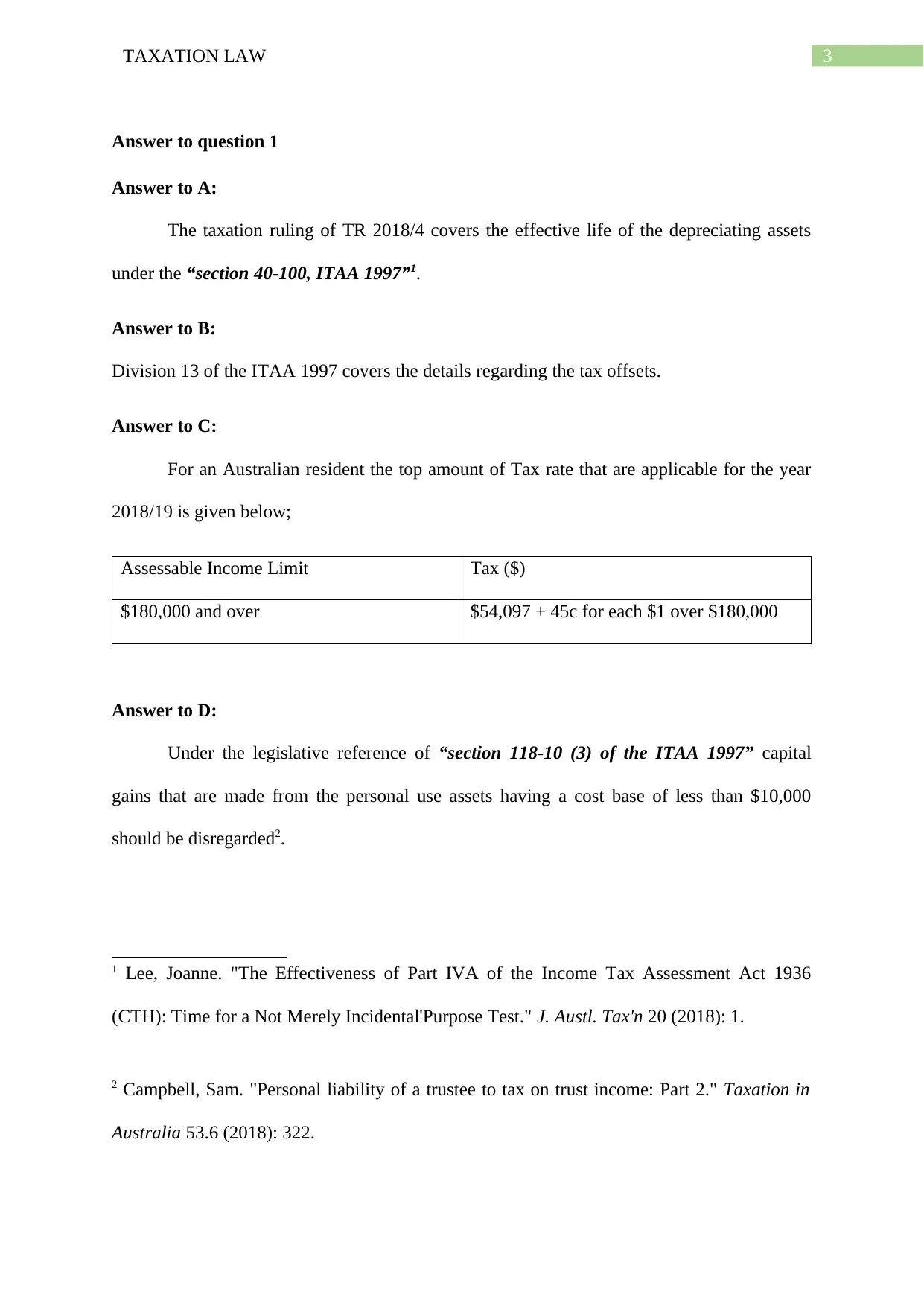
3TAXATION LAW
Answer to question 1
Answer to A:
The taxation ruling of TR 2018/4 covers the effective life of the depreciating assets
under the “section 40-100, ITAA 1997”1.
Answer to B:
Division 13 of the ITAA 1997 covers the details regarding the tax offsets.
Answer to C:
For an Australian resident the top amount of Tax rate that are applicable for the year
2018/19 is given below;
Assessable Income Limit Tax ($)
$180,000 and over $54,097 + 45c for each $1 over $180,000
Answer to D:
Under the legislative reference of “section 118-10 (3) of the ITAA 1997” capital
gains that are made from the personal use assets having a cost base of less than $10,000
should be disregarded2.
1 Lee, Joanne. "The Effectiveness of Part IVA of the Income Tax Assessment Act 1936
(CTH): Time for a Not Merely Incidental'Purpose Test." J. Austl. Tax'n 20 (2018): 1.
2 Campbell, Sam. "Personal liability of a trustee to tax on trust income: Part 2." Taxation in
Australia 53.6 (2018): 322.
Answer to question 1
Answer to A:
The taxation ruling of TR 2018/4 covers the effective life of the depreciating assets
under the “section 40-100, ITAA 1997”1.
Answer to B:
Division 13 of the ITAA 1997 covers the details regarding the tax offsets.
Answer to C:
For an Australian resident the top amount of Tax rate that are applicable for the year
2018/19 is given below;
Assessable Income Limit Tax ($)
$180,000 and over $54,097 + 45c for each $1 over $180,000
Answer to D:
Under the legislative reference of “section 118-10 (3) of the ITAA 1997” capital
gains that are made from the personal use assets having a cost base of less than $10,000
should be disregarded2.
1 Lee, Joanne. "The Effectiveness of Part IVA of the Income Tax Assessment Act 1936
(CTH): Time for a Not Merely Incidental'Purpose Test." J. Austl. Tax'n 20 (2018): 1.
2 Campbell, Sam. "Personal liability of a trustee to tax on trust income: Part 2." Taxation in
Australia 53.6 (2018): 322.
Paraphrase This Document
Need a fresh take? Get an instant paraphrase of this document with our AI Paraphraser
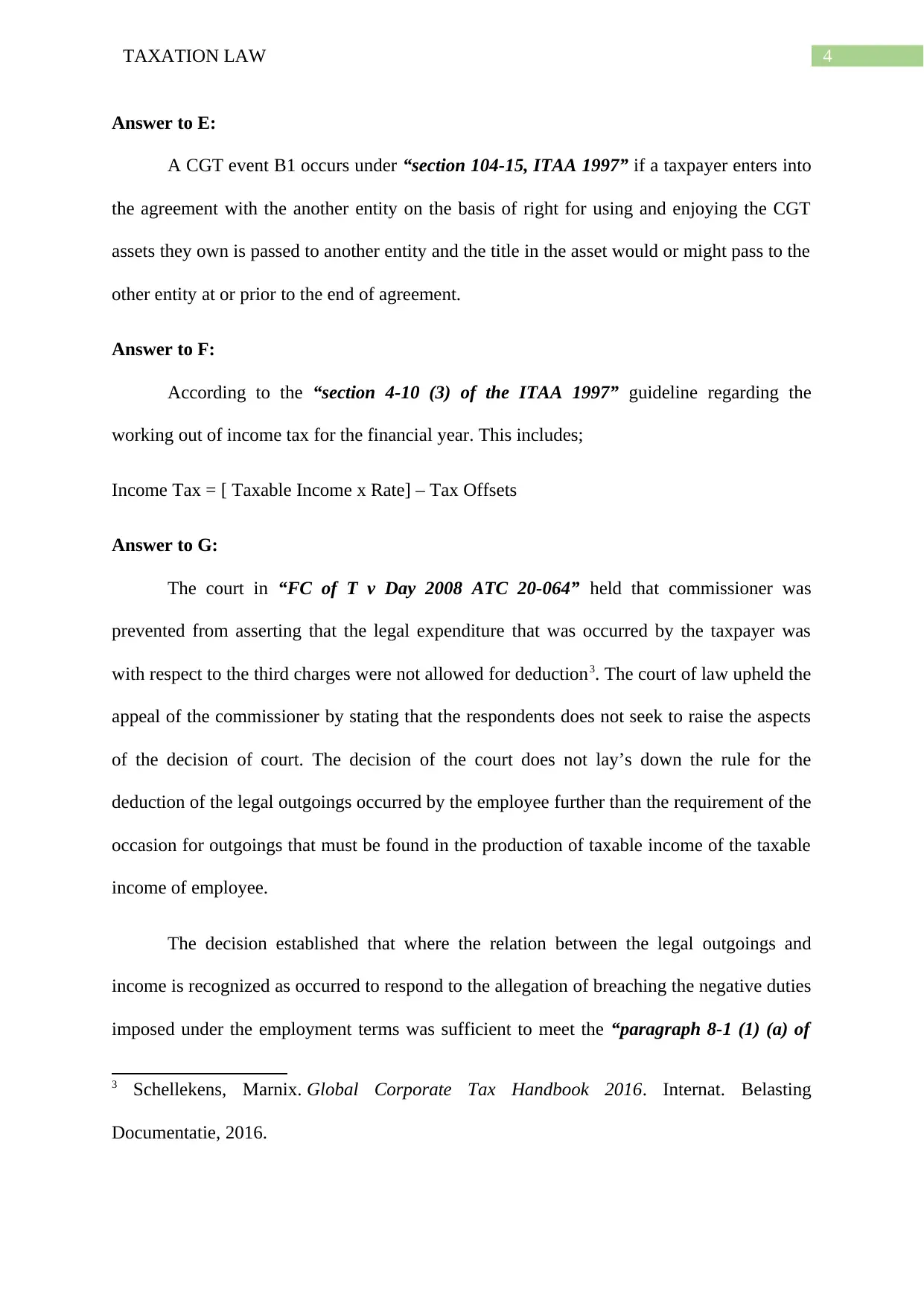
4TAXATION LAW
Answer to E:
A CGT event B1 occurs under “section 104-15, ITAA 1997” if a taxpayer enters into
the agreement with the another entity on the basis of right for using and enjoying the CGT
assets they own is passed to another entity and the title in the asset would or might pass to the
other entity at or prior to the end of agreement.
Answer to F:
According to the “section 4-10 (3) of the ITAA 1997” guideline regarding the
working out of income tax for the financial year. This includes;
Income Tax = [ Taxable Income x Rate] – Tax Offsets
Answer to G:
The court in “FC of T v Day 2008 ATC 20-064” held that commissioner was
prevented from asserting that the legal expenditure that was occurred by the taxpayer was
with respect to the third charges were not allowed for deduction3. The court of law upheld the
appeal of the commissioner by stating that the respondents does not seek to raise the aspects
of the decision of court. The decision of the court does not lay’s down the rule for the
deduction of the legal outgoings occurred by the employee further than the requirement of the
occasion for outgoings that must be found in the production of taxable income of the taxable
income of employee.
The decision established that where the relation between the legal outgoings and
income is recognized as occurred to respond to the allegation of breaching the negative duties
imposed under the employment terms was sufficient to meet the “paragraph 8-1 (1) (a) of
3 Schellekens, Marnix. Global Corporate Tax Handbook 2016. Internat. Belasting
Documentatie, 2016.
Answer to E:
A CGT event B1 occurs under “section 104-15, ITAA 1997” if a taxpayer enters into
the agreement with the another entity on the basis of right for using and enjoying the CGT
assets they own is passed to another entity and the title in the asset would or might pass to the
other entity at or prior to the end of agreement.
Answer to F:
According to the “section 4-10 (3) of the ITAA 1997” guideline regarding the
working out of income tax for the financial year. This includes;
Income Tax = [ Taxable Income x Rate] – Tax Offsets
Answer to G:
The court in “FC of T v Day 2008 ATC 20-064” held that commissioner was
prevented from asserting that the legal expenditure that was occurred by the taxpayer was
with respect to the third charges were not allowed for deduction3. The court of law upheld the
appeal of the commissioner by stating that the respondents does not seek to raise the aspects
of the decision of court. The decision of the court does not lay’s down the rule for the
deduction of the legal outgoings occurred by the employee further than the requirement of the
occasion for outgoings that must be found in the production of taxable income of the taxable
income of employee.
The decision established that where the relation between the legal outgoings and
income is recognized as occurred to respond to the allegation of breaching the negative duties
imposed under the employment terms was sufficient to meet the “paragraph 8-1 (1) (a) of
3 Schellekens, Marnix. Global Corporate Tax Handbook 2016. Internat. Belasting
Documentatie, 2016.
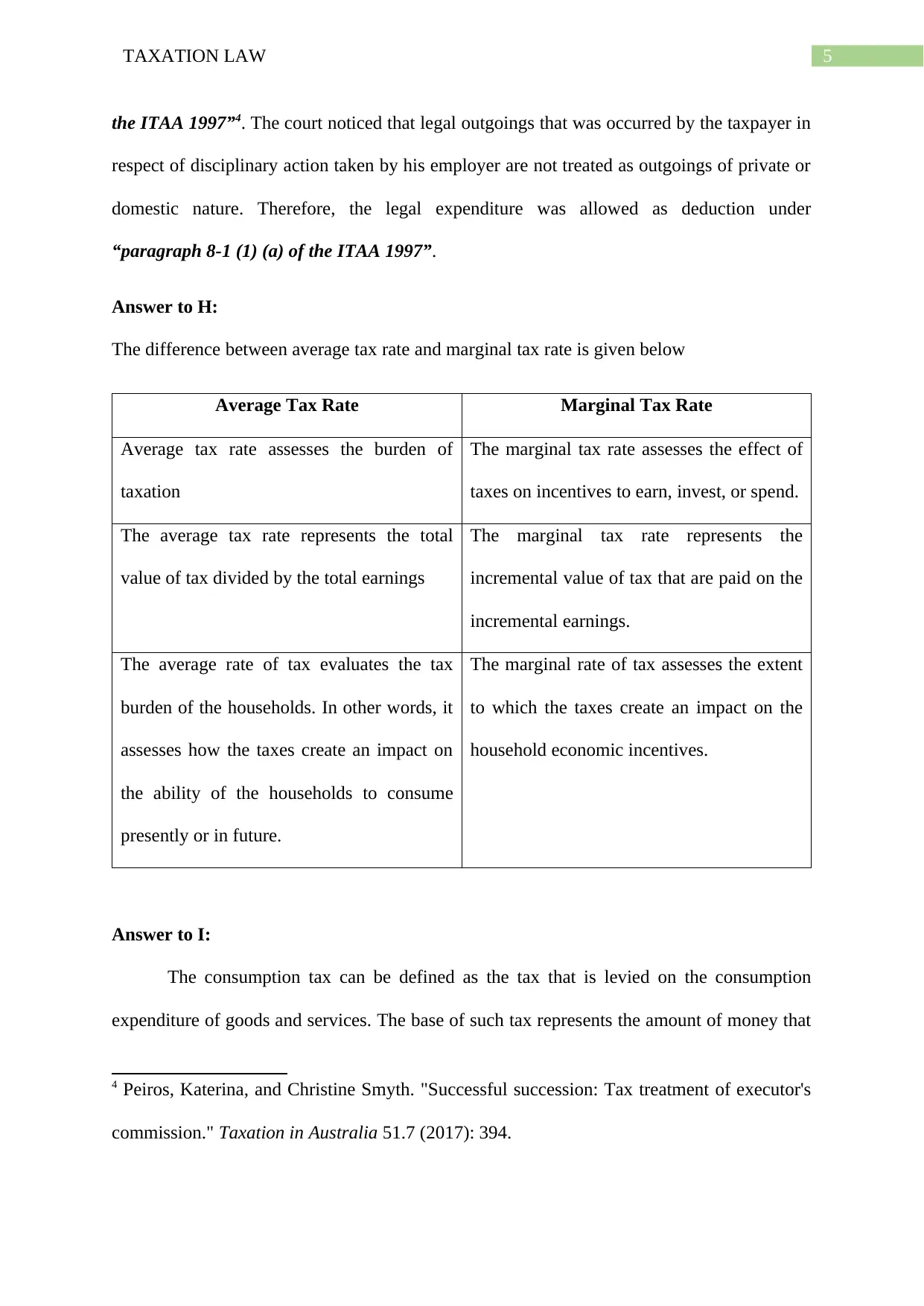
5TAXATION LAW
the ITAA 1997”4. The court noticed that legal outgoings that was occurred by the taxpayer in
respect of disciplinary action taken by his employer are not treated as outgoings of private or
domestic nature. Therefore, the legal expenditure was allowed as deduction under
“paragraph 8-1 (1) (a) of the ITAA 1997”.
Answer to H:
The difference between average tax rate and marginal tax rate is given below
Average Tax Rate Marginal Tax Rate
Average tax rate assesses the burden of
taxation
The marginal tax rate assesses the effect of
taxes on incentives to earn, invest, or spend.
The average tax rate represents the total
value of tax divided by the total earnings
The marginal tax rate represents the
incremental value of tax that are paid on the
incremental earnings.
The average rate of tax evaluates the tax
burden of the households. In other words, it
assesses how the taxes create an impact on
the ability of the households to consume
presently or in future.
The marginal rate of tax assesses the extent
to which the taxes create an impact on the
household economic incentives.
Answer to I:
The consumption tax can be defined as the tax that is levied on the consumption
expenditure of goods and services. The base of such tax represents the amount of money that
4 Peiros, Katerina, and Christine Smyth. "Successful succession: Tax treatment of executor's
commission." Taxation in Australia 51.7 (2017): 394.
the ITAA 1997”4. The court noticed that legal outgoings that was occurred by the taxpayer in
respect of disciplinary action taken by his employer are not treated as outgoings of private or
domestic nature. Therefore, the legal expenditure was allowed as deduction under
“paragraph 8-1 (1) (a) of the ITAA 1997”.
Answer to H:
The difference between average tax rate and marginal tax rate is given below
Average Tax Rate Marginal Tax Rate
Average tax rate assesses the burden of
taxation
The marginal tax rate assesses the effect of
taxes on incentives to earn, invest, or spend.
The average tax rate represents the total
value of tax divided by the total earnings
The marginal tax rate represents the
incremental value of tax that are paid on the
incremental earnings.
The average rate of tax evaluates the tax
burden of the households. In other words, it
assesses how the taxes create an impact on
the ability of the households to consume
presently or in future.
The marginal rate of tax assesses the extent
to which the taxes create an impact on the
household economic incentives.
Answer to I:
The consumption tax can be defined as the tax that is levied on the consumption
expenditure of goods and services. The base of such tax represents the amount of money that
4 Peiros, Katerina, and Christine Smyth. "Successful succession: Tax treatment of executor's
commission." Taxation in Australia 51.7 (2017): 394.
⊘ This is a preview!⊘
Do you want full access?
Subscribe today to unlock all pages.

Trusted by 1+ million students worldwide
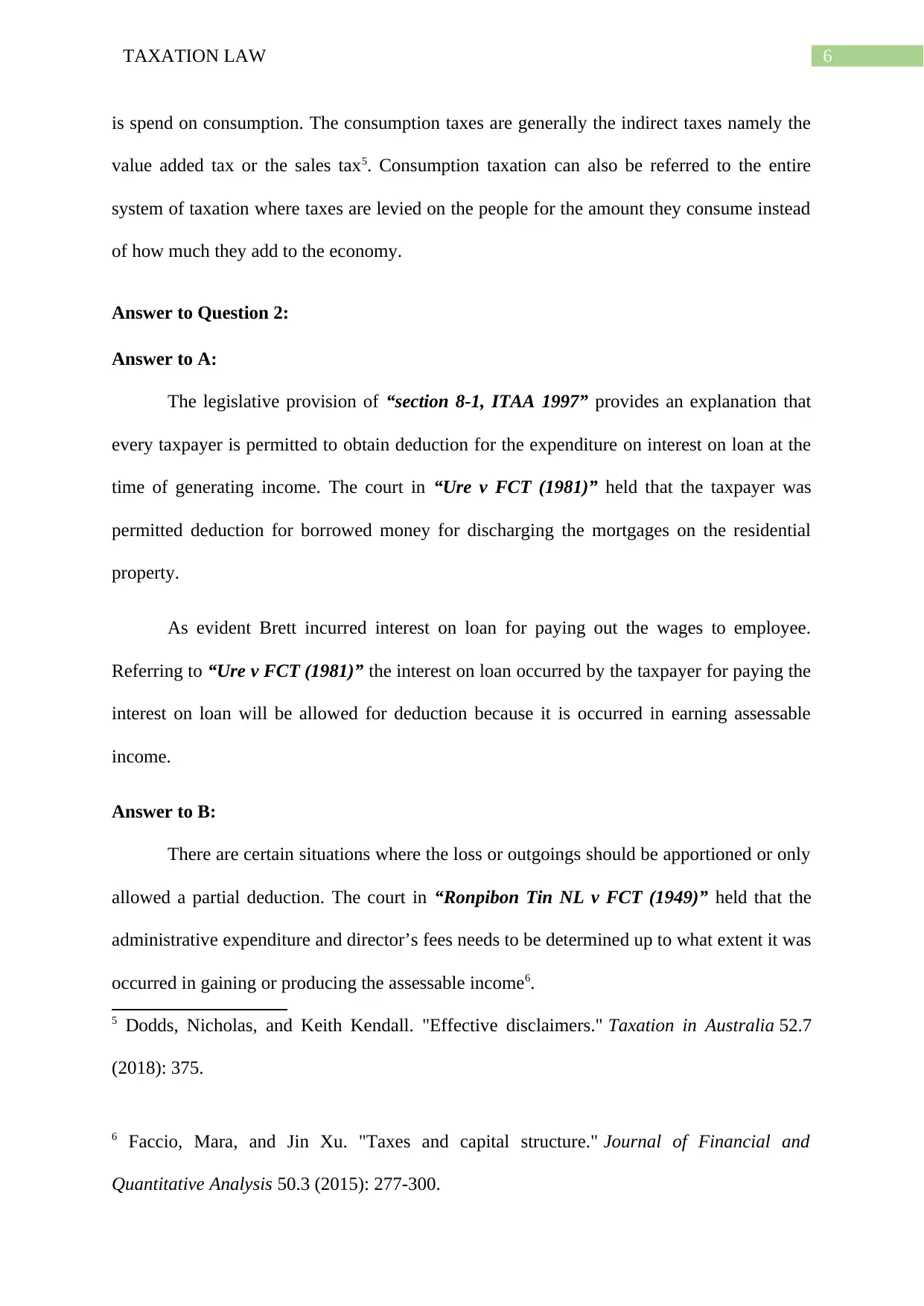
6TAXATION LAW
is spend on consumption. The consumption taxes are generally the indirect taxes namely the
value added tax or the sales tax5. Consumption taxation can also be referred to the entire
system of taxation where taxes are levied on the people for the amount they consume instead
of how much they add to the economy.
Answer to Question 2:
Answer to A:
The legislative provision of “section 8-1, ITAA 1997” provides an explanation that
every taxpayer is permitted to obtain deduction for the expenditure on interest on loan at the
time of generating income. The court in “Ure v FCT (1981)” held that the taxpayer was
permitted deduction for borrowed money for discharging the mortgages on the residential
property.
As evident Brett incurred interest on loan for paying out the wages to employee.
Referring to “Ure v FCT (1981)” the interest on loan occurred by the taxpayer for paying the
interest on loan will be allowed for deduction because it is occurred in earning assessable
income.
Answer to B:
There are certain situations where the loss or outgoings should be apportioned or only
allowed a partial deduction. The court in “Ronpibon Tin NL v FCT (1949)” held that the
administrative expenditure and director’s fees needs to be determined up to what extent it was
occurred in gaining or producing the assessable income6.
5 Dodds, Nicholas, and Keith Kendall. "Effective disclaimers." Taxation in Australia 52.7
(2018): 375.
6 Faccio, Mara, and Jin Xu. "Taxes and capital structure." Journal of Financial and
Quantitative Analysis 50.3 (2015): 277-300.
is spend on consumption. The consumption taxes are generally the indirect taxes namely the
value added tax or the sales tax5. Consumption taxation can also be referred to the entire
system of taxation where taxes are levied on the people for the amount they consume instead
of how much they add to the economy.
Answer to Question 2:
Answer to A:
The legislative provision of “section 8-1, ITAA 1997” provides an explanation that
every taxpayer is permitted to obtain deduction for the expenditure on interest on loan at the
time of generating income. The court in “Ure v FCT (1981)” held that the taxpayer was
permitted deduction for borrowed money for discharging the mortgages on the residential
property.
As evident Brett incurred interest on loan for paying out the wages to employee.
Referring to “Ure v FCT (1981)” the interest on loan occurred by the taxpayer for paying the
interest on loan will be allowed for deduction because it is occurred in earning assessable
income.
Answer to B:
There are certain situations where the loss or outgoings should be apportioned or only
allowed a partial deduction. The court in “Ronpibon Tin NL v FCT (1949)” held that the
administrative expenditure and director’s fees needs to be determined up to what extent it was
occurred in gaining or producing the assessable income6.
5 Dodds, Nicholas, and Keith Kendall. "Effective disclaimers." Taxation in Australia 52.7
(2018): 375.
6 Faccio, Mara, and Jin Xu. "Taxes and capital structure." Journal of Financial and
Quantitative Analysis 50.3 (2015): 277-300.
Paraphrase This Document
Need a fresh take? Get an instant paraphrase of this document with our AI Paraphraser
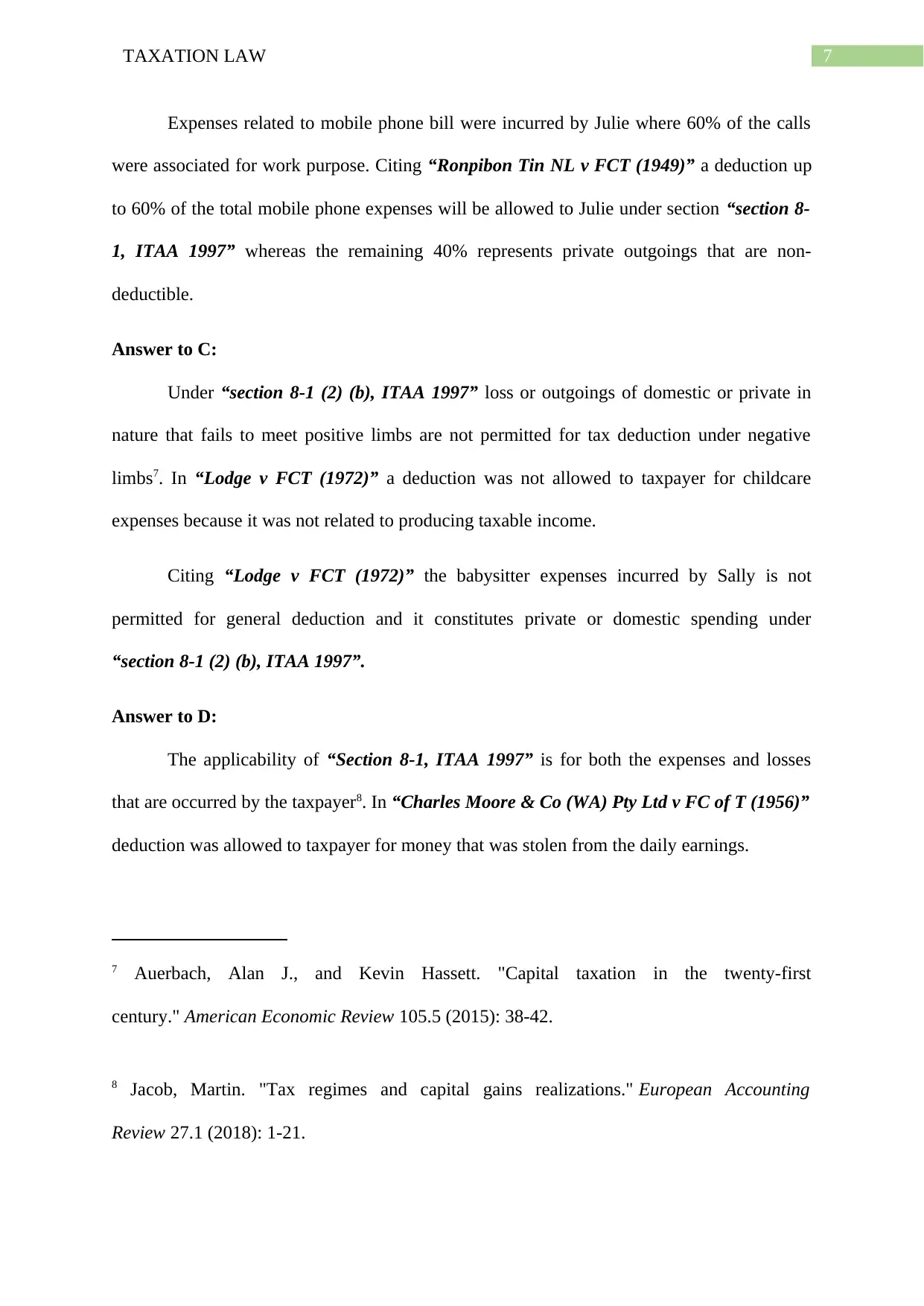
7TAXATION LAW
Expenses related to mobile phone bill were incurred by Julie where 60% of the calls
were associated for work purpose. Citing “Ronpibon Tin NL v FCT (1949)” a deduction up
to 60% of the total mobile phone expenses will be allowed to Julie under section “section 8-
1, ITAA 1997” whereas the remaining 40% represents private outgoings that are non-
deductible.
Answer to C:
Under “section 8-1 (2) (b), ITAA 1997” loss or outgoings of domestic or private in
nature that fails to meet positive limbs are not permitted for tax deduction under negative
limbs7. In “Lodge v FCT (1972)” a deduction was not allowed to taxpayer for childcare
expenses because it was not related to producing taxable income.
Citing “Lodge v FCT (1972)” the babysitter expenses incurred by Sally is not
permitted for general deduction and it constitutes private or domestic spending under
“section 8-1 (2) (b), ITAA 1997”.
Answer to D:
The applicability of “Section 8-1, ITAA 1997” is for both the expenses and losses
that are occurred by the taxpayer8. In “Charles Moore & Co (WA) Pty Ltd v FC of T (1956)”
deduction was allowed to taxpayer for money that was stolen from the daily earnings.
7 Auerbach, Alan J., and Kevin Hassett. "Capital taxation in the twenty-first
century." American Economic Review 105.5 (2015): 38-42.
8 Jacob, Martin. "Tax regimes and capital gains realizations." European Accounting
Review 27.1 (2018): 1-21.
Expenses related to mobile phone bill were incurred by Julie where 60% of the calls
were associated for work purpose. Citing “Ronpibon Tin NL v FCT (1949)” a deduction up
to 60% of the total mobile phone expenses will be allowed to Julie under section “section 8-
1, ITAA 1997” whereas the remaining 40% represents private outgoings that are non-
deductible.
Answer to C:
Under “section 8-1 (2) (b), ITAA 1997” loss or outgoings of domestic or private in
nature that fails to meet positive limbs are not permitted for tax deduction under negative
limbs7. In “Lodge v FCT (1972)” a deduction was not allowed to taxpayer for childcare
expenses because it was not related to producing taxable income.
Citing “Lodge v FCT (1972)” the babysitter expenses incurred by Sally is not
permitted for general deduction and it constitutes private or domestic spending under
“section 8-1 (2) (b), ITAA 1997”.
Answer to D:
The applicability of “Section 8-1, ITAA 1997” is for both the expenses and losses
that are occurred by the taxpayer8. In “Charles Moore & Co (WA) Pty Ltd v FC of T (1956)”
deduction was allowed to taxpayer for money that was stolen from the daily earnings.
7 Auerbach, Alan J., and Kevin Hassett. "Capital taxation in the twenty-first
century." American Economic Review 105.5 (2015): 38-42.
8 Jacob, Martin. "Tax regimes and capital gains realizations." European Accounting
Review 27.1 (2018): 1-21.
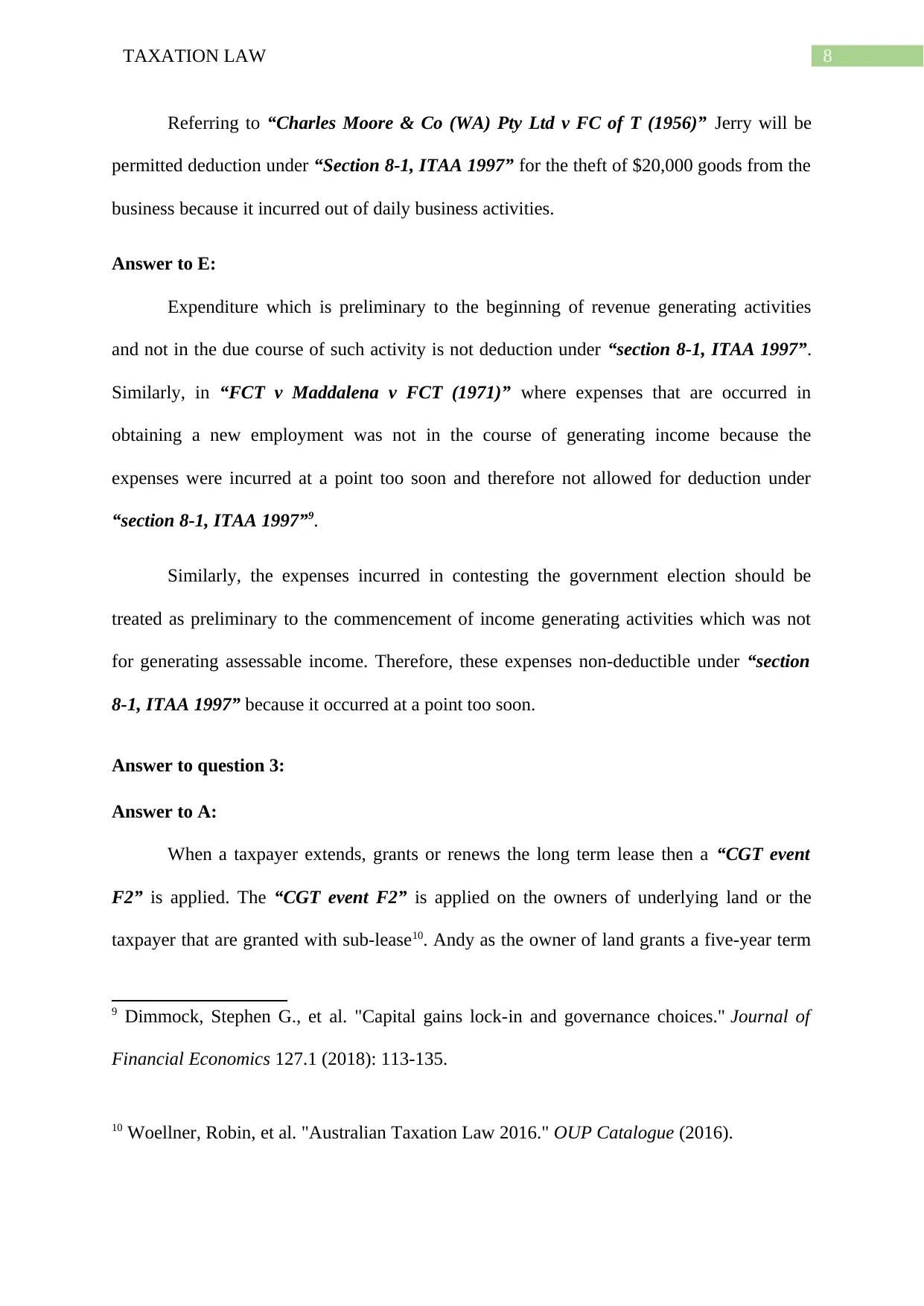
8TAXATION LAW
Referring to “Charles Moore & Co (WA) Pty Ltd v FC of T (1956)” Jerry will be
permitted deduction under “Section 8-1, ITAA 1997” for the theft of $20,000 goods from the
business because it incurred out of daily business activities.
Answer to E:
Expenditure which is preliminary to the beginning of revenue generating activities
and not in the due course of such activity is not deduction under “section 8-1, ITAA 1997”.
Similarly, in “FCT v Maddalena v FCT (1971)” where expenses that are occurred in
obtaining a new employment was not in the course of generating income because the
expenses were incurred at a point too soon and therefore not allowed for deduction under
“section 8-1, ITAA 1997”9.
Similarly, the expenses incurred in contesting the government election should be
treated as preliminary to the commencement of income generating activities which was not
for generating assessable income. Therefore, these expenses non-deductible under “section
8-1, ITAA 1997” because it occurred at a point too soon.
Answer to question 3:
Answer to A:
When a taxpayer extends, grants or renews the long term lease then a “CGT event
F2” is applied. The “CGT event F2” is applied on the owners of underlying land or the
taxpayer that are granted with sub-lease10. Andy as the owner of land grants a five-year term
9 Dimmock, Stephen G., et al. "Capital gains lock-in and governance choices." Journal of
Financial Economics 127.1 (2018): 113-135.
10 Woellner, Robin, et al. "Australian Taxation Law 2016." OUP Catalogue (2016).
Referring to “Charles Moore & Co (WA) Pty Ltd v FC of T (1956)” Jerry will be
permitted deduction under “Section 8-1, ITAA 1997” for the theft of $20,000 goods from the
business because it incurred out of daily business activities.
Answer to E:
Expenditure which is preliminary to the beginning of revenue generating activities
and not in the due course of such activity is not deduction under “section 8-1, ITAA 1997”.
Similarly, in “FCT v Maddalena v FCT (1971)” where expenses that are occurred in
obtaining a new employment was not in the course of generating income because the
expenses were incurred at a point too soon and therefore not allowed for deduction under
“section 8-1, ITAA 1997”9.
Similarly, the expenses incurred in contesting the government election should be
treated as preliminary to the commencement of income generating activities which was not
for generating assessable income. Therefore, these expenses non-deductible under “section
8-1, ITAA 1997” because it occurred at a point too soon.
Answer to question 3:
Answer to A:
When a taxpayer extends, grants or renews the long term lease then a “CGT event
F2” is applied. The “CGT event F2” is applied on the owners of underlying land or the
taxpayer that are granted with sub-lease10. Andy as the owner of land grants a five-year term
9 Dimmock, Stephen G., et al. "Capital gains lock-in and governance choices." Journal of
Financial Economics 127.1 (2018): 113-135.
10 Woellner, Robin, et al. "Australian Taxation Law 2016." OUP Catalogue (2016).
⊘ This is a preview!⊘
Do you want full access?
Subscribe today to unlock all pages.

Trusted by 1+ million students worldwide
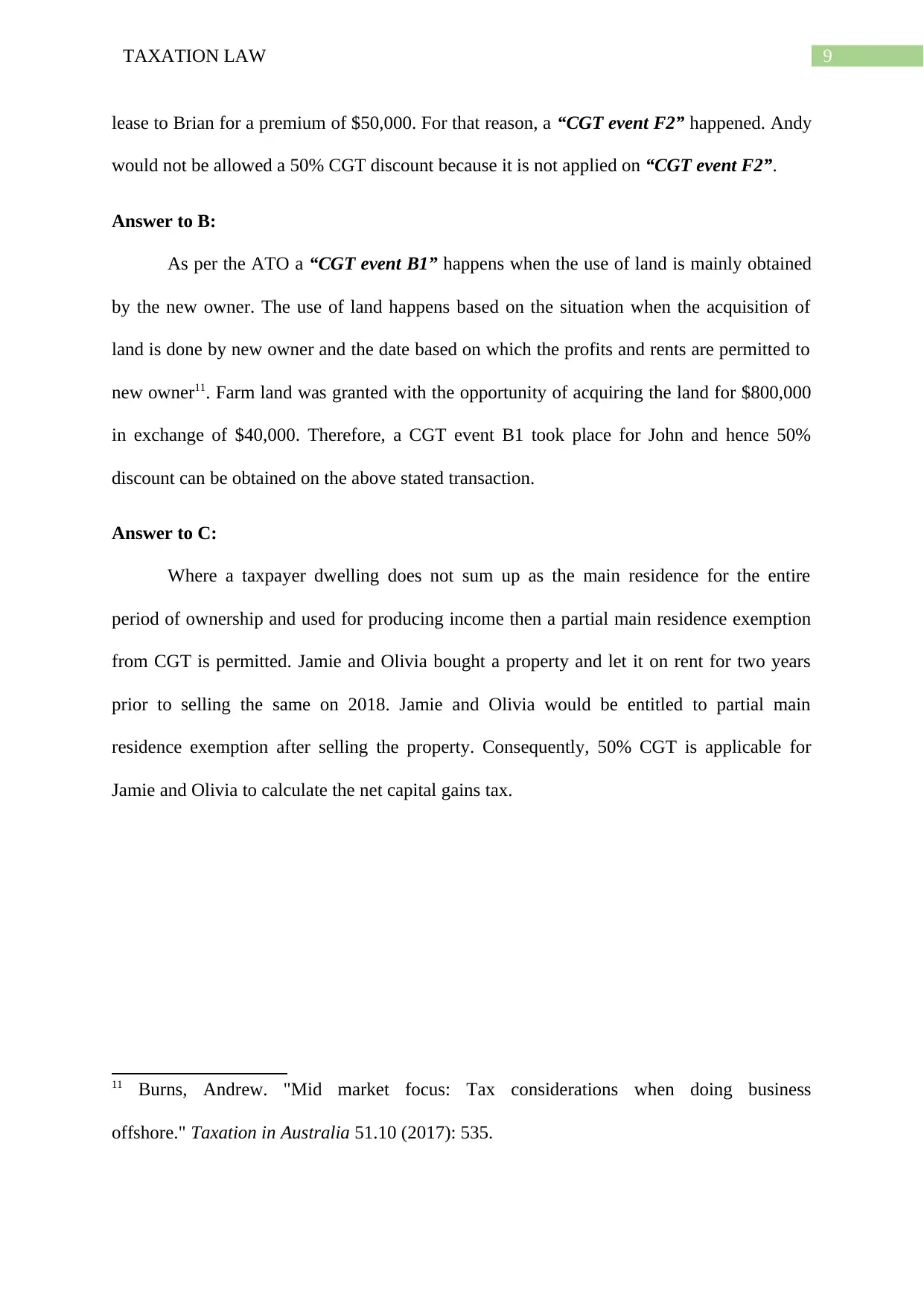
9TAXATION LAW
lease to Brian for a premium of $50,000. For that reason, a “CGT event F2” happened. Andy
would not be allowed a 50% CGT discount because it is not applied on “CGT event F2”.
Answer to B:
As per the ATO a “CGT event B1” happens when the use of land is mainly obtained
by the new owner. The use of land happens based on the situation when the acquisition of
land is done by new owner and the date based on which the profits and rents are permitted to
new owner11. Farm land was granted with the opportunity of acquiring the land for $800,000
in exchange of $40,000. Therefore, a CGT event B1 took place for John and hence 50%
discount can be obtained on the above stated transaction.
Answer to C:
Where a taxpayer dwelling does not sum up as the main residence for the entire
period of ownership and used for producing income then a partial main residence exemption
from CGT is permitted. Jamie and Olivia bought a property and let it on rent for two years
prior to selling the same on 2018. Jamie and Olivia would be entitled to partial main
residence exemption after selling the property. Consequently, 50% CGT is applicable for
Jamie and Olivia to calculate the net capital gains tax.
11 Burns, Andrew. "Mid market focus: Tax considerations when doing business
offshore." Taxation in Australia 51.10 (2017): 535.
lease to Brian for a premium of $50,000. For that reason, a “CGT event F2” happened. Andy
would not be allowed a 50% CGT discount because it is not applied on “CGT event F2”.
Answer to B:
As per the ATO a “CGT event B1” happens when the use of land is mainly obtained
by the new owner. The use of land happens based on the situation when the acquisition of
land is done by new owner and the date based on which the profits and rents are permitted to
new owner11. Farm land was granted with the opportunity of acquiring the land for $800,000
in exchange of $40,000. Therefore, a CGT event B1 took place for John and hence 50%
discount can be obtained on the above stated transaction.
Answer to C:
Where a taxpayer dwelling does not sum up as the main residence for the entire
period of ownership and used for producing income then a partial main residence exemption
from CGT is permitted. Jamie and Olivia bought a property and let it on rent for two years
prior to selling the same on 2018. Jamie and Olivia would be entitled to partial main
residence exemption after selling the property. Consequently, 50% CGT is applicable for
Jamie and Olivia to calculate the net capital gains tax.
11 Burns, Andrew. "Mid market focus: Tax considerations when doing business
offshore." Taxation in Australia 51.10 (2017): 535.
Paraphrase This Document
Need a fresh take? Get an instant paraphrase of this document with our AI Paraphraser
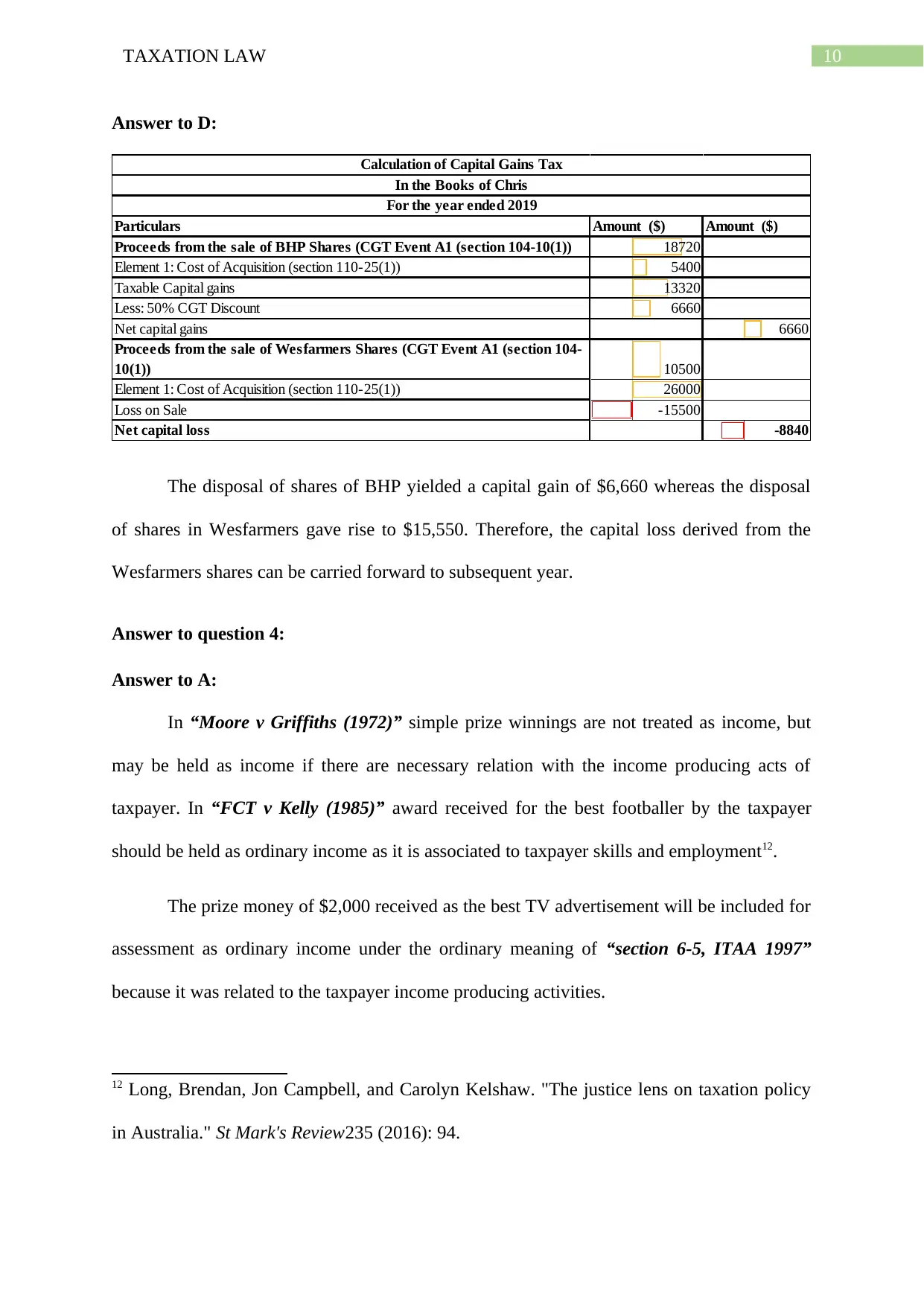
10TAXATION LAW
Answer to D:
Particulars Amount ($) Amount ($)
Proceeds from the sale of BHP Shares (CGT Event A1 (section 104-10(1)) 18720
Element 1: Cost of Acquisition (section 110-25(1)) 5400
Taxable Capital gains 13320
Less: 50% CGT Discount 6660
Net capital gains 6660
Proceeds from the sale of Wesfarmers Shares (CGT Event A1 (section 104-
10(1)) 10500
Element 1: Cost of Acquisition (section 110-25(1)) 26000
Loss on Sale -15500
Net capital loss -8840
Calculation of Capital Gains Tax
In the Books of Chris
For the year ended 2019
The disposal of shares of BHP yielded a capital gain of $6,660 whereas the disposal
of shares in Wesfarmers gave rise to $15,550. Therefore, the capital loss derived from the
Wesfarmers shares can be carried forward to subsequent year.
Answer to question 4:
Answer to A:
In “Moore v Griffiths (1972)” simple prize winnings are not treated as income, but
may be held as income if there are necessary relation with the income producing acts of
taxpayer. In “FCT v Kelly (1985)” award received for the best footballer by the taxpayer
should be held as ordinary income as it is associated to taxpayer skills and employment12.
The prize money of $2,000 received as the best TV advertisement will be included for
assessment as ordinary income under the ordinary meaning of “section 6-5, ITAA 1997”
because it was related to the taxpayer income producing activities.
12 Long, Brendan, Jon Campbell, and Carolyn Kelshaw. "The justice lens on taxation policy
in Australia." St Mark's Review235 (2016): 94.
Answer to D:
Particulars Amount ($) Amount ($)
Proceeds from the sale of BHP Shares (CGT Event A1 (section 104-10(1)) 18720
Element 1: Cost of Acquisition (section 110-25(1)) 5400
Taxable Capital gains 13320
Less: 50% CGT Discount 6660
Net capital gains 6660
Proceeds from the sale of Wesfarmers Shares (CGT Event A1 (section 104-
10(1)) 10500
Element 1: Cost of Acquisition (section 110-25(1)) 26000
Loss on Sale -15500
Net capital loss -8840
Calculation of Capital Gains Tax
In the Books of Chris
For the year ended 2019
The disposal of shares of BHP yielded a capital gain of $6,660 whereas the disposal
of shares in Wesfarmers gave rise to $15,550. Therefore, the capital loss derived from the
Wesfarmers shares can be carried forward to subsequent year.
Answer to question 4:
Answer to A:
In “Moore v Griffiths (1972)” simple prize winnings are not treated as income, but
may be held as income if there are necessary relation with the income producing acts of
taxpayer. In “FCT v Kelly (1985)” award received for the best footballer by the taxpayer
should be held as ordinary income as it is associated to taxpayer skills and employment12.
The prize money of $2,000 received as the best TV advertisement will be included for
assessment as ordinary income under the ordinary meaning of “section 6-5, ITAA 1997”
because it was related to the taxpayer income producing activities.
12 Long, Brendan, Jon Campbell, and Carolyn Kelshaw. "The justice lens on taxation policy
in Australia." St Mark's Review235 (2016): 94.
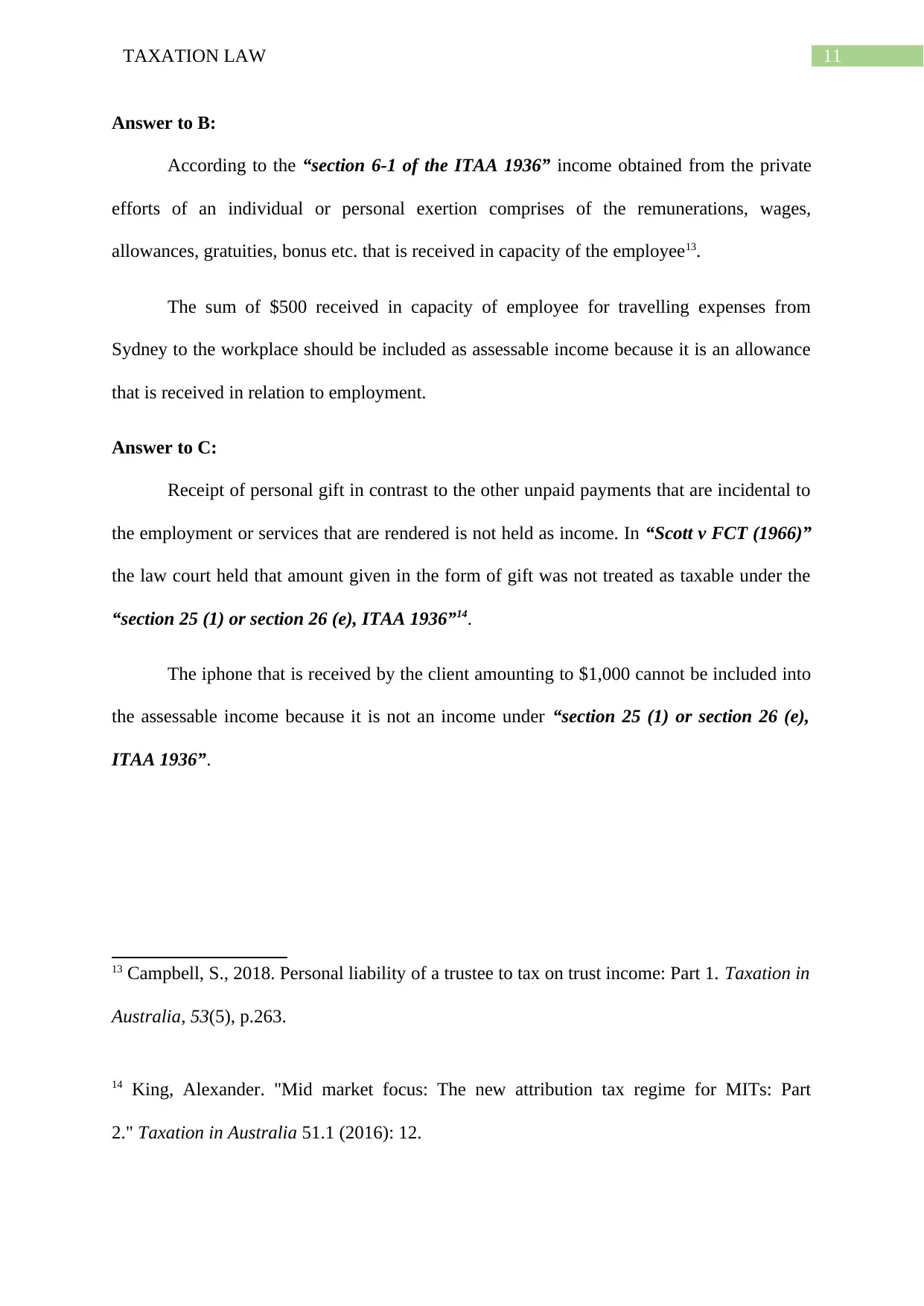
11TAXATION LAW
Answer to B:
According to the “section 6-1 of the ITAA 1936” income obtained from the private
efforts of an individual or personal exertion comprises of the remunerations, wages,
allowances, gratuities, bonus etc. that is received in capacity of the employee13.
The sum of $500 received in capacity of employee for travelling expenses from
Sydney to the workplace should be included as assessable income because it is an allowance
that is received in relation to employment.
Answer to C:
Receipt of personal gift in contrast to the other unpaid payments that are incidental to
the employment or services that are rendered is not held as income. In “Scott v FCT (1966)”
the law court held that amount given in the form of gift was not treated as taxable under the
“section 25 (1) or section 26 (e), ITAA 1936”14.
The iphone that is received by the client amounting to $1,000 cannot be included into
the assessable income because it is not an income under “section 25 (1) or section 26 (e),
ITAA 1936”.
13 Campbell, S., 2018. Personal liability of a trustee to tax on trust income: Part 1. Taxation in
Australia, 53(5), p.263.
14 King, Alexander. "Mid market focus: The new attribution tax regime for MITs: Part
2." Taxation in Australia 51.1 (2016): 12.
Answer to B:
According to the “section 6-1 of the ITAA 1936” income obtained from the private
efforts of an individual or personal exertion comprises of the remunerations, wages,
allowances, gratuities, bonus etc. that is received in capacity of the employee13.
The sum of $500 received in capacity of employee for travelling expenses from
Sydney to the workplace should be included as assessable income because it is an allowance
that is received in relation to employment.
Answer to C:
Receipt of personal gift in contrast to the other unpaid payments that are incidental to
the employment or services that are rendered is not held as income. In “Scott v FCT (1966)”
the law court held that amount given in the form of gift was not treated as taxable under the
“section 25 (1) or section 26 (e), ITAA 1936”14.
The iphone that is received by the client amounting to $1,000 cannot be included into
the assessable income because it is not an income under “section 25 (1) or section 26 (e),
ITAA 1936”.
13 Campbell, S., 2018. Personal liability of a trustee to tax on trust income: Part 1. Taxation in
Australia, 53(5), p.263.
14 King, Alexander. "Mid market focus: The new attribution tax regime for MITs: Part
2." Taxation in Australia 51.1 (2016): 12.
⊘ This is a preview!⊘
Do you want full access?
Subscribe today to unlock all pages.

Trusted by 1+ million students worldwide
1 out of 19
Related Documents
Your All-in-One AI-Powered Toolkit for Academic Success.
+13062052269
info@desklib.com
Available 24*7 on WhatsApp / Email
![[object Object]](/_next/static/media/star-bottom.7253800d.svg)
Unlock your academic potential
Copyright © 2020–2025 A2Z Services. All Rights Reserved. Developed and managed by ZUCOL.





